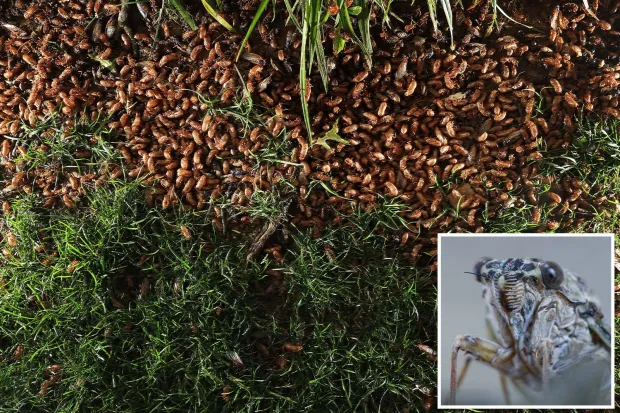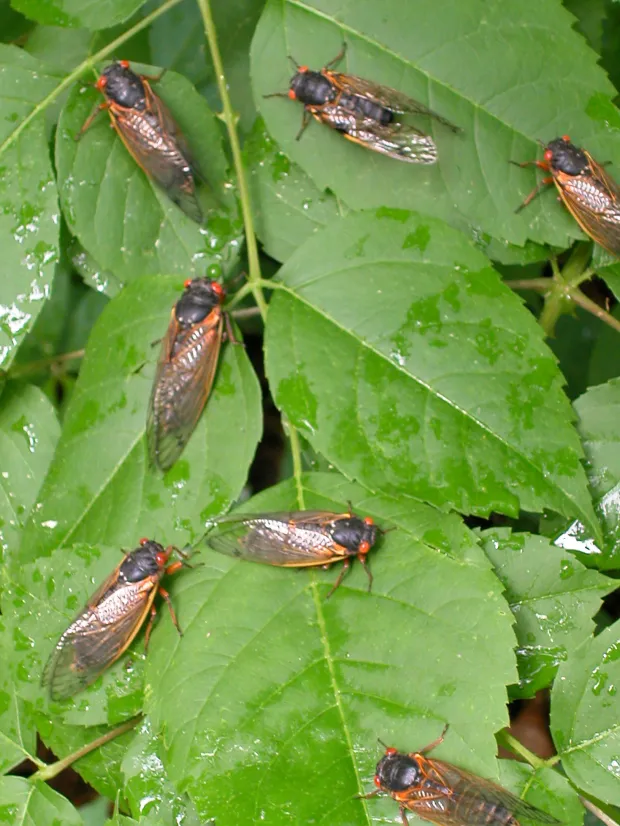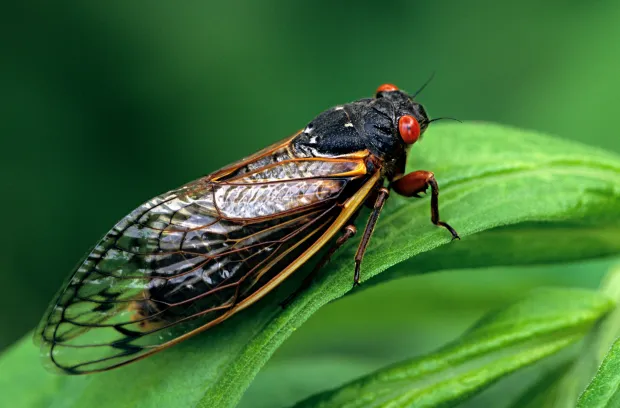Trillions of bugs to swarm mating frenzy
LOVE BUGS Trillions of bugs to swarm in ‘once-per-221-years’ mating frenzy in weeks – it last happened to the Founding Fathers
Three weeks into the process, many of the cicadas will be high in the trees
The Sun • March 29, 2024
TRILLIONS of cicadas are set to invade the eastern US for the first time in 221 years, scientists say.
In April, two large broods of periodical cicadas are going to emerge from the ground around the US for a large mating frenzy.
“Billions, even trillions, of cicadas are going to emerge at the same time across 17 states,” Chris Simon, a professor in UConn’s Department of Ecology and Evolutionary Biology, told Live Science.
Brood XIII and XIX have been living underground for 17 and 13 years respectively, and will emerge for the first time together in 221 years.
Periodical broods are found in eastern North America and tend to emerge in large numbers.
Once they hatch, the nymphs feed off root sap underground until it’s time to mate.
Mating season has been described as a noisy and chaotic display that could happen for weeks.
An event like this hasn’t occurred since 1803 when Thomas Jefferson was president, and the next occurrence will not be until 2244.
“The co-emergence of any two broods of different cycles is rare because the cycles are both prime numbers,” John Cooley, founder of the Periodical Cicada Project and a professor in UConn’s Department of Ecology and Evolutionary Biology, told the publication.
“Any given 13- and 17-year broods will only co-emerge once every 13 x 17 = 221 years.”
However, despite the large volume of cicadas that will appear next, it won’t look too different from other emergences.
In the first week, people will be able to spot the cicadas sitting on vegetation after they shed their exoskeleton around the morning hours.
Afterward, they will climb trees, and the males will emit a loud noise to attract females.
The females will then follow suit making clicking noises that increase as mating gets underway.
From there, the females can lay their eggs, and a new batch of cicadas will appear the next morning.
For the most part, the broods do not appear in the same location except for a small woodland area in Springfield, Illinois.
“The broods won’t overlap significantly due to the latitudinal spread involved,” Cooley explained.
“But there will be a lot of cicadas … just as there are a lot of ants, flies. Insects come in large numbers.”
While the co-emergence of these two groups has not happened in hundreds of years, other 13-year and 17-year broods have happened around the same time.
“2015 was the last time a 13-year brood emerged with a 17-year brood when Brood XXIII emerged with Brood IV. However, the two broods weren’t geographically close,” Simon told Live Science.
“Similarly, adjacent Brood IV and Brood XIX both appeared in 1998 but, again, weren’t close.”
Because of the limited time between them, the two broods will most likely not interbreed with each other
“Even if the broods were to interbreed, any offspring would be indistinguishable from cicadas that were not hybrids,” Simon said.
According to the researcher, even the life cycles have stayed the same between interbred cicadas.
“Scientists in the past have speculated that mating between 13-year and 17-year periodical cicadas would not create an intermediate life cycle (eg, 15-year); instead, the offspring would be either 13-year or 17-year, but not both,” Simon said.
“We still only see either 13 or 17-year cicadas in nature. Whether one life cycle is dominant to another is unknown. And, importantly, there are very few places where 13-year and 17-year cicadas currently overlap.”
Within two to six weeks, most of the cicadas will die after reproducing or in the process of emergence.
Three weeks into the process, many of the cicadas will be high in the trees, where they laid their eggs.
The eggs will eventually fall to lower ground, where they will hatch and burrow underground.
“Emerging isn’t without risk, as many of the cicadas will be eaten by predators, while others may be killed by later cicadas walking on them while their outer casing is still soft,” Simon said.
“Some will survive to move into the higher vegetation and mate and lay eggs.”




